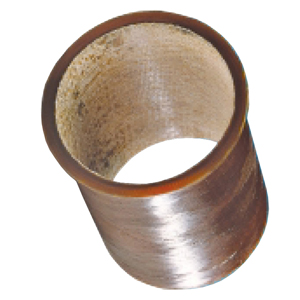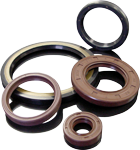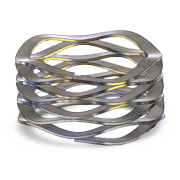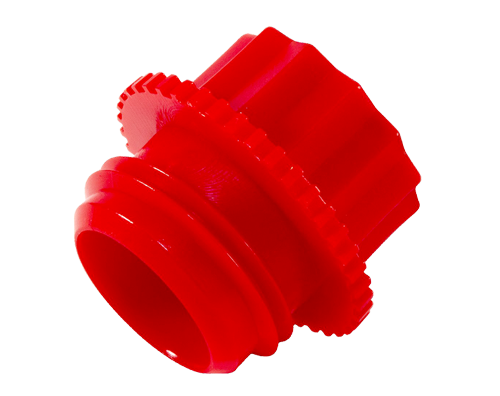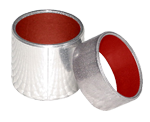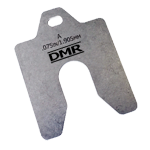Home >> Slide >> Fiber-Lube Bushings >> HT Fiber-Lube
HT Fiber Lube
Daemar’s Fiber Lube composite bushings allow true self lubrication. Ideal for long-term highly loaded applications. Additional benefits include: low friction values and resistance to corrosion.
Product Description
The Fiber-Lube™ HT bearing is a high load, low RPM bearing designed for applications where self-lubrication is desired, but conventional composite bearings will not perform at high temperatures. This product has been designed to provide excellent performance at elevated temperatures. With a glass transition temperature of over 450ºF this epoxy filament wound structure exhibits superb performance over extended exposure to elevated temperatures. The bearing material is focused on applications where the bearing will be exposed to temperatures up to 450ºF.
In addition to its high compressive properties (in both static and dynamic modes), this bearing material is inherently self-lubricating. The self-lubrication capability of our new material means that the use of expensive high temperature external lubricants such as polyurea grease, lithium grease, some bentone greases, as well as advanced ester based oils and complex thickening systems may no longer be necessary.
The Fiber-Lube™ HT bearing creates a high strength, self-lubricating journal bearing material that can offer performance enhancements over greased systems, as well as graphite impregnated bronze bushings, some iron-copper graphites, polysulfone, PEEK, and polymide bearing materials.
Product Schematic
This bearing is based on the same filament wound structure as the Fiber-Lube™ FW Series bearing and has the same wear liner. The result is that the HT bearing has a high static and dynamic load capacity. The HT bearing is also inherently self-lubricating through the same film transfer process as the Fiber Series bearing.
The result of a higher temperature resin matrix, the same high strength filament wound backing, and the same self-lubrication process combine to make the HT bearing an ideal solution for high temperature applications.
The Fiber-Lube™ High Temperature bearing was originated from development work the company was doing on high temperature, high RPM, high radially stressed composite materials for ring reinforced commutators. The end was replacing steel-mica rings with a high strength composite material.
Typical Applications
Fiber-Lube™ High Temperature applications are not just for elevated temperature environments but also for applications where the bearing may need to resist thermal expansion during operation. One example of this is in snowmobile clutch market. In these applications, the clutch speed goes from 0 to very high RPM’s in micro-seconds (and vice versa). During this cycling, friction is rising because speed is being dramatically increased. As the friction goes up so does the temperature of the associated components. A high temperature composite bearing material can resist these expansion phenomena and as a result offer better long term wear, improved bearing durability, and less seizure opportunity than conventional metal bearing materials.
Thermal Properties
Thermal Conductivity (BTU/hr/sq ft/°F/in)…. 1.8 to 2.3
Specific Heat (BTU / lb / °F)………………………… 0.27
Coefficient of Thermal Expansion (in/in/°F). 5 to 7×104
Heat Resistance, Continuous…………………… ±200°C
Electrical Properties
Insulation Resistance (ohm/8” Length)….. 2.38×1012
Volume Resistivity ( ohm/cm )…………. 2.41×1015
Surface Resistivity (ohms )………………… 2.92×1015
Dialectric Strength, Short Time (volts/mil)Min….. 100
Dialectric Constant (60 cps)……………………….. 4.15
Dissipation Factor (60 cps)……………………… 0.0094
Impulse (11/240u Wave (Axial) volts/mil).. 400 to 550
Power Factor @ 60cps (100v pct mx)
As Received………………………………………. 5.0
@ 100°C…………………………………………… 10.0
After 24 hours @ 100°F @ 98% rel. hum. ….. 10.0
Physical Properties
Hoop Strength (Fy x 103)……………………………. 120
Tensile Strength (Ft x 103 PSI)………………………. 20
Flexural Strength, Axial (Fbx x 103 PSI)…………. 20
Poisson’s Ratio, Axial ………………………………. 0.08
Shear Modulus (Gxy x 104 PSI)……………………… 0.6
Elastic Modulus (Ex x 104 PSI)………………………. 0.6
Elastic Modulus, Transverse (Ey x 104 PSI)……… 5.0
Thermal Properties
Ultimate Compression Strength (PSI)…………. 60,000
Unit Load Limit (PSI)……………………………… 30,000
Temperature Range ……………………………… ±200°C
Water Absorption (2 hours)………………………. 0.12%
Water Absorption (24 hours)……………………… 0.16%
Specific Gravity……………………………………….. 1.87
Maximum Velocity (SFM)…………………………….. 10


